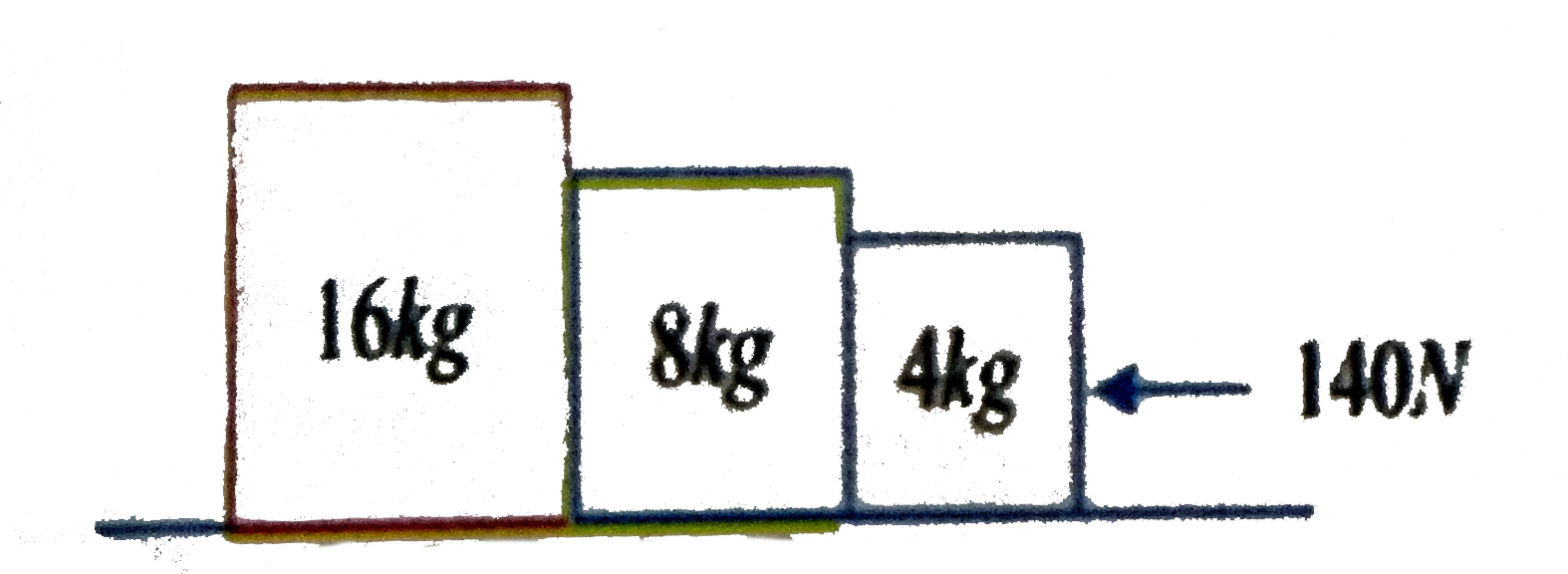A bomb of mass 8 Kg exlpodes on a smooth horizontal surface , into three fragments of masses 1 Kg , 3 Kg and 4Kg . 4Kg fragment moves with a speed 1 m/ s along eastward and 3 Kg fragement moves with a speed 1 m/s along northward . find the magnitude and direction of the velocity of 1Kg fragment .Solution in Bengali

According to the law conservation of momentum . From the figure we get ,
along east - west direction ,1 vcosθ=4×1
or vcosθ=4
along north - south direction 1⋅vsinθ=3×1
or vsinθ=3
∴, v2(cos2θ+sin2θ)=42+32
or v2=25or,v=5m⋅s−1
Again ,vsinθvcosθ=34
or,tanθ=34or,θ=tan−134
∴ the velocity of the 1Kg fragement is 5m⋅s−1 in a direction making an angle of tan−1(3)4 south odf west .
Topper's Solved these Questions
- WBCHSE QUESTION PAPER -2019BOOK - CHHAYA PUBLICATIONCHAPTER - WBCHSE QUESTION PAPER -2019EXERCISE - SECTION - II ( GROUP -D)
10 Videos
- WBCHSE QUESTION PAPER -2019BOOK - CHHAYA PUBLICATIONCHAPTER - WBCHSE QUESTION PAPER -2019EXERCISE - SECTION - II ( GROUP -B)
8 Videos
- VISCOSITY AND SURFACE TENSIONBOOK - CHHAYA PUBLICATIONCHAPTER - VISCOSITY AND SURFACE TENSIONEXERCISE - EXERCISE (CBSE SCANNER)
9 Videos
- WORK AND ENERGYBOOK - CHHAYA PUBLICATIONCHAPTER - WORK AND ENERGYEXERCISE - CBSE SCANNER
27 Videos
Similar Questions
Equations of trajectory of a projectile are x=4 t, y=3t−5t2 , where x and y are in metre and t is in second . Find (i) maximum height attained by the projectille , (ii) horizontal range of the projectile .
View SolutionA particle moves with uniform acceleration and the distance travelled in t - th second is st=3+2t . Find the initial velocity of the particle .
View SolutionState and prove Bernoulli's theorem.
View SolutionProve that the total mechanical energy remains constant for a ball mass m dropped from a tower of height h.
View SolutionA bomb of mass 3.0 kg explodes in air into two pieces of masses 2.0 kg and 1.0 kg . The smaller mass goes at a speed of 80 m//s . The total energy impared to the two fragments is :
View SolutionA bomb of mass 16kg at rest explodes into two pieces of masses 4kg and 12kg. If KE of 4kg mass is 288J, what is the velocity (in ms−1 of the other piece of 12kg ?
View SolutionThree masses of 16kg,8kg and 4kg are placed in contact as shown in Figure. If a force of 140N is applied on 4kg mass, then the force on 16kg will be

View SolutionA bomb of mass 3.0 kg explodes in air into two pieces of masses 2.0 kg and 1.0 kg . The total energy imparted to the two fragment is
View SolutionTwo particles of mass 1 kg and 0.5 kg are moving in the same direction with speed of 2 m//s and 6 m/s respectively on a smooth horizontal surface. The speed of centre of mass of the system is
View SolutionA body of mass 5 kg explodes at rest into three fragments with masses in the ratio 1 : 1 : 3. The fragments with equal masses fly in mutually perpendicular directions with speeds of 21 m/s . The velocity of the heaviest fragment will be
View SolutionA shell at rest at origin explodes into three fragments of masses 1 kg, 2 kg and m kg. The fragments of masses 1 kg and 2 kg fly off with speeds 12 m//s along x-axis and 8 m//s along y- axis. If the m kg piece flies off with speed of 40 m//s then find the total mass of the shell.
View SolutionA body of mass 5 kg explodes at rest into three fragments with masses in the ratio 1 : 1 : 3. The fragments with equal masses fly in mutually perpendicular directions with speeds of 21 m/s. The velocity of the heaviest fragment will be -
View SolutionA body of mass 1 kg moving in the x-direction, suddenly explodes into two fragments of mass 1/8 kg and 7/8 kg. An instant later, the smaller fragment is 0.14 m above the x-axis. The position of the heavier fragment is:
View SolutionThree masses of 16 kg, 8 kg and 4kg are placed in contact as shown in Figure. If a force of 140 N is applied on 4kg mass, then the force on 16kg will be

View SolutionA bomb of mass 60 kg moving uniformly with a velocity of 10m/s explodes spontaneously into two fragments of 40 kg and 20 kg. If the velocity of the larger fragments is zero, then calculate the velocity of the smaller fragement.
View Solution
